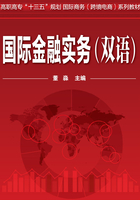
Exercises
Ⅰ.Multiple Choices Questions
1. The international monetary system is broadly defined as .
A. the set of conventions, rules, procedures and institutions that govern the conduct of financial relations between nations
B. the set of rules to manage every country’s central banks
C. the set of rules to solve trade disputes between countries
D. the set of rules to develop world economy
2. Under the gold standard, the exchange rate was fixed because .
A. each currency unit could be converted to a weight of gold
B. the gold could be exported and imported with no restrictions
C. gold coins could be freely minted
D. all of the above
3. When the gold standard prevailed, the United States fixed the price of gold at  20.646 per ounce and the Britain fixed the price at 4.252 per ounce. Now suppose the fees for transporting one ounce of gold were approximately
20.646 per ounce and the Britain fixed the price at 4.252 per ounce. Now suppose the fees for transporting one ounce of gold were approximately  0.03 per sterling of gold. Then the exchange rate of dollar versus sterling would fluctuate between .
0.03 per sterling of gold. Then the exchange rate of dollar versus sterling would fluctuate between .
A.  4.8856/
4.8856/ and
and  4.8256/
4.8256/
B.  4.9042/
4.9042/ and
and  4.8070/
4.8070/
C.  4.9770/
4.9770/ and
and  4.7463/
4.7463/
D. We don’t know, because it depends on the supply and demand forces in the foreign exchange market
4. Which of the following is true regarding the collapse of the gold standard system?
A. The World War Ⅰ had many European countries suspend convertibility of their currencies into gold
B. The political costs of maintaining the overvalued pound were so great in the United Kingdom
C. Nations facing 1929—1933 worldwide recession decided to pursue objectives such as higher employment rates and real growth rates, rather than to maintain the exchange value of their currencies
D. All of the above are the reasons that the gold standard finally collapsed
5. The U.S. dollar was designated as the international currency in international settlements under the Bretton Woods system. The dollar was accepted by the rest of the world because .
A. it could be used to purchase U.S. goods and services
B. it could be converted to gold at a price of  35/ounce
35/ounce
C. the U.S. was the only super power at that time
D. the IMF forced the rest of the world to use dollar to settle international debts
6. The principal function of the International Monetary Fund (IMF) was originally to .
A. act as a supranational regulatory agency for all countries’ central banks
B. lend to member nations experiencing a shortage of foreign exchange reserves
C. finance postwar reconstruction, particularly in Europe and Japan
D. reduce trade barriers and settle disputes among countries relating to currency negotiations
7. One of the benefits of the creation of euro is that it .
A. promotes trades and investments in those euro-zone countries
B. makes those euro-zone countries avoid the exchange rate risks
C. helps those euro-zone countries restrain inflation
D. All of the above are benefits for euro-zone countries
8. The IMF constitution was amended to allow member nations to determine their own exchange rate arrangements by the .
A. Louvre Accord
B. Jamaica Accord
C. Smithsonian Agreement
D. Plaza Agreement
9.Which of the following is NOT true regarding the 1976 Jamaica Accord?
A. It formally legitimized the floating exchange system
B. It aimed at increasing the importance of SDRs in international reserves
C. It emphasized the importance of gold in international reserves
D. All of the above are true
10. The exchange rate system refers to .
A. a country’s internal economic policies such as employment, inflation and interest rate levels
B. a country’s monetary policies
C. a country’s fiscal polices
D. a country’s choice as to which exchange rate regime such as fixed or floating or between to follow
Ⅱ.Questions
1. Describe the gold standard. What forced the gold standard collapse?
2. What are the pros and cons of the gold standard ?
3. Describe the Bretton Woods system.
4. What are the main advantages for EMU countries to use euro?
5. List the pros and cons of the dollarization.